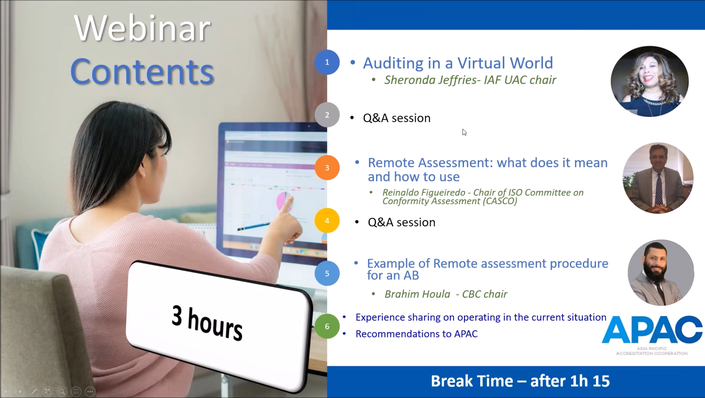
APAC Webinar - Remote audits and assessments, May 2020
APAC webinar on remote assessment
This Webinar was organised on the 21st of May 2020 by the APAC Capacity Building Committee to discuss with members the topic of remote assessment and remote auditing amid the COVID-19 outbreak and the challenges taht ABs and CABs encounter during this period.
116 participants attended the Webinar and three lectures were given as follows:
1- "Auditing in a Virtual World" by Sheronda Jeffries- IAF UAC chair
2- "Remote Assessment: what does it mean and how to use" by Reinaldo Figueiredo - Chair of ISO Committee on Conformity Assessment (CASCO)
3- "Example of Remote assessment procedure for an AB" by Brahim Houla - APAC CBC chair
You will find in this Webinar the videos of the different sessions, the presentations and other useful material.
We hope you enjoy this webinar.
Your Instructor

The Asia Pacific Accreditation Cooperation (APAC) was established on 1 January 2019 by the amalgamation of two former regional accreditation cooperations – the Asia Pacific Laboratory Accreditation Cooperation (APLAC) and the Pacific Accreditation Cooperation (PAC).
Role of APAC
APAC ‘s primary role is to manage and expand a mutual recognition arrangement (MRA) among accreditation bodies in the Asia Pacific region. The MRA facilitates the acceptance of conformity assessment results (e.g. test reports, test certificates, inspection reports, and certification) across the region and with other regions around the world. Conformity assessment results that are produced by conformity assessment bodies (CABs) that have been accredited by one APAC MRA signatory are accepted by all the other APAC MRA signatories. This mutual recognition and acceptance of conformity assessment results reduces the need to undertake duplicate testing, inspection or certification, thus saving time and money, increasing economic efficiency and facilitating international trade.
APAC’s members include accreditation bodies, accreditation focal points and other organisations that have an interest in accredited conformity assessment results.
APAC is recognized by the Asia Pacific Economic Cooperation (APEC) as one of four APEC Specialist Regional Bodies(SRBs) that support the work of the APEC Sub-Committee on Standards and Conformance.
History of APLAC
APLAC was initiated in 1992 as a forum for laboratory accreditation bodies in the Asia Pacific region. The APLAC Memorandum of Understanding (MOU), formally establishing APLAC, was signed in April 1995 by the founding members.
The inaugural signing of the APLAC Mutual Recognition Arrangement (MRA) occurred on 19 November 1997, with 7 accreditation bodies signing the MRA for testing and calibration. The MRA was extended in November 2003 to include inspection, and in April 2007 to refer specifically to ISO 15189 (the international standard applied to medical laboratories) that had previously been included under the “testing” scope of the MRA. The inaugural signing of the extended APLAC MRA to include accreditation of reference material producers (RMPs) took place in December 2007. The inaugural signing of the extended APLAC MRA to include accreditation of proficiency testing providers (PTPs) took place in June 2014. At the end of 2018, APLAC had 38 accreditation bodies that were MRA signatories.
History of PAC
PAC was initiated in 1995, and approved the initial version of its Multilateral Accreditation Arrangement (MLA) in 1997. In 1998 the first 5 accreditation bodies signed the MLA for the scope of accredited quality management systems (QMS) certification. Over the following years other scopes where added such as other types of management system certification (e.g. environmental management systems, food safety management systems), product certification, person certification and greenhouse gas validation and verification. At the end of 2018 PAC had 26 accreditation bodies that were MLA signatories.
